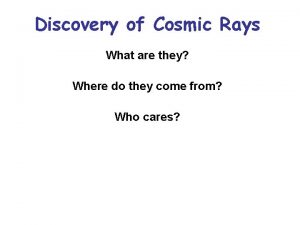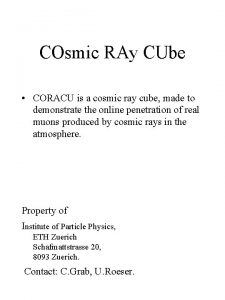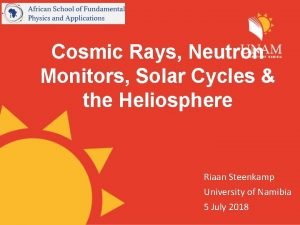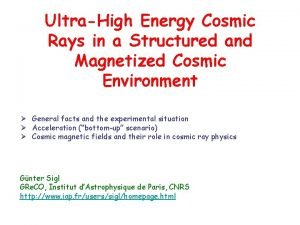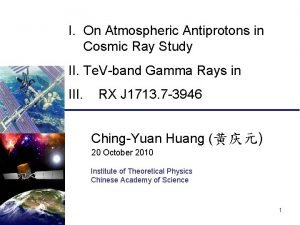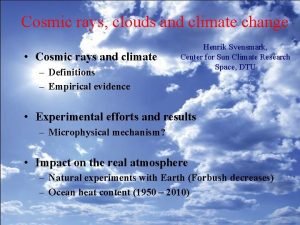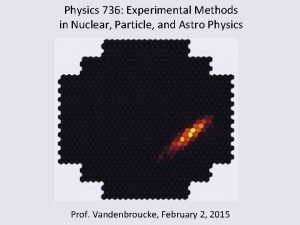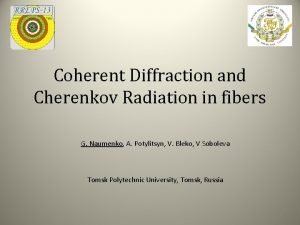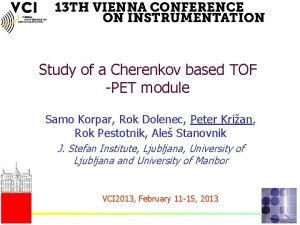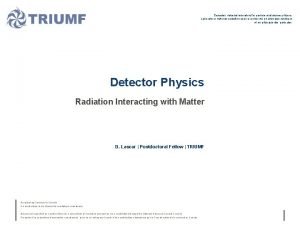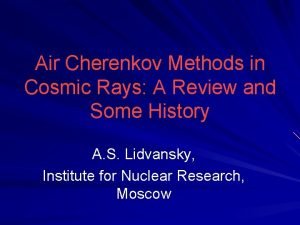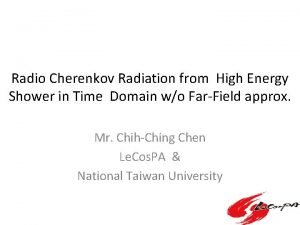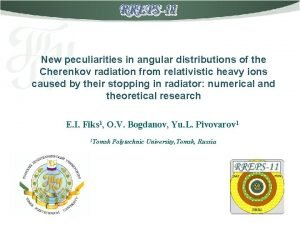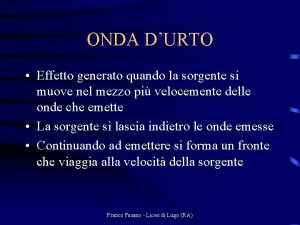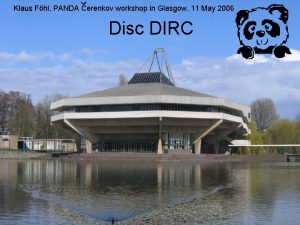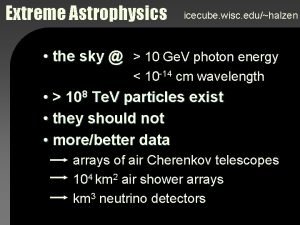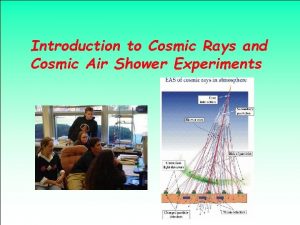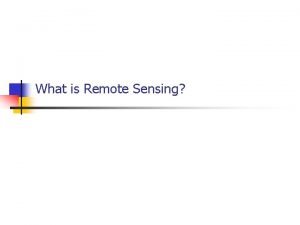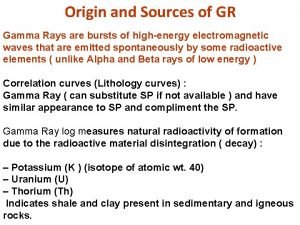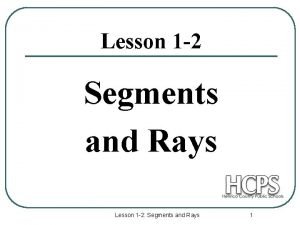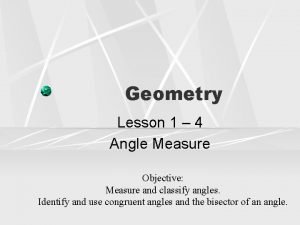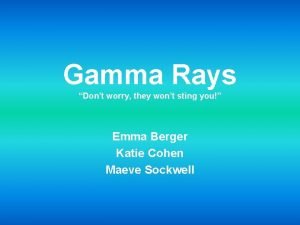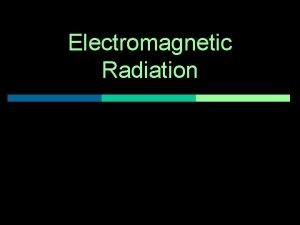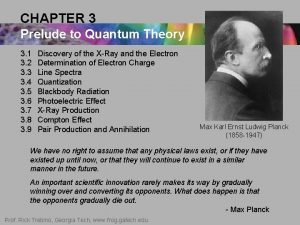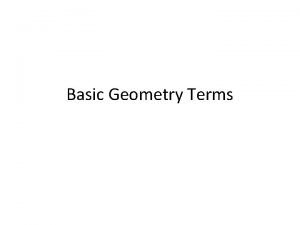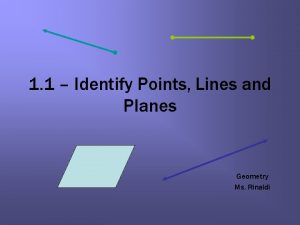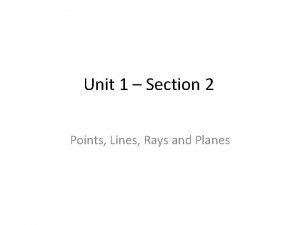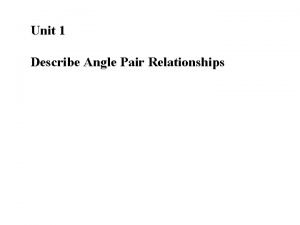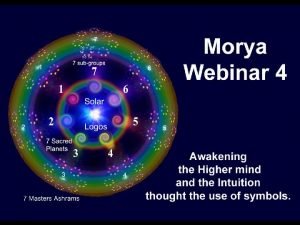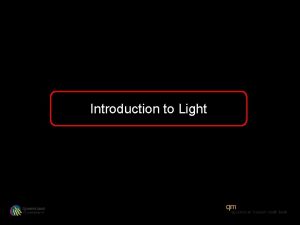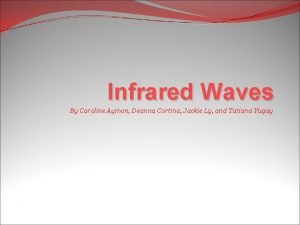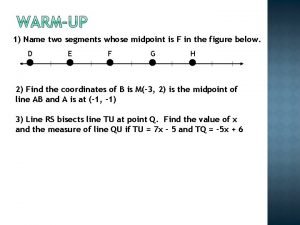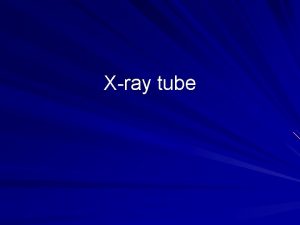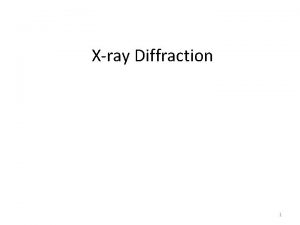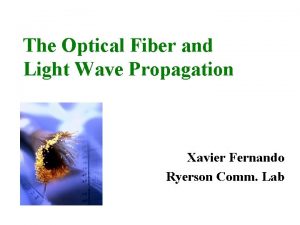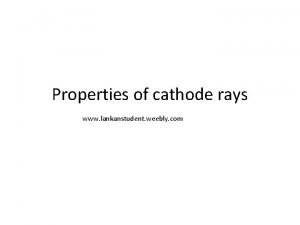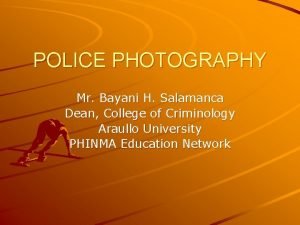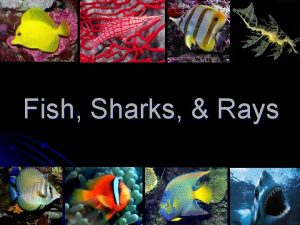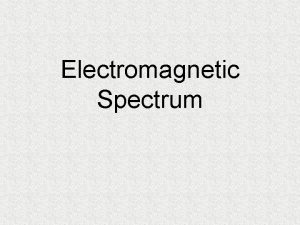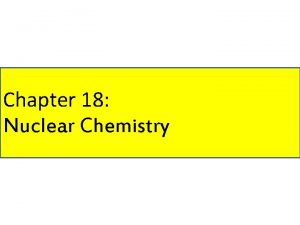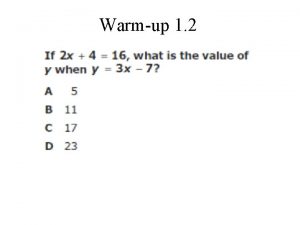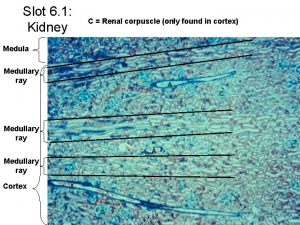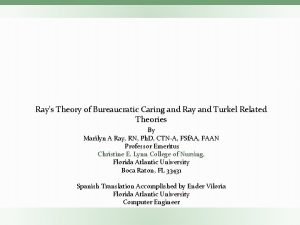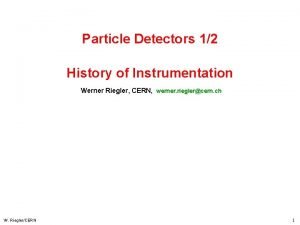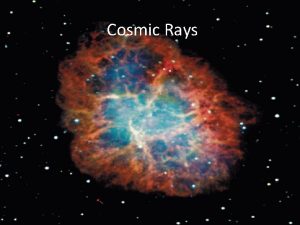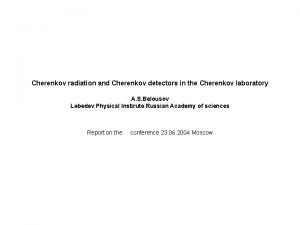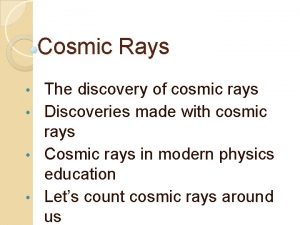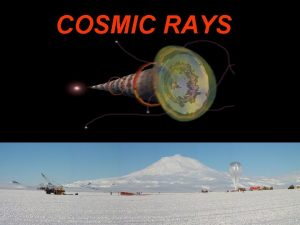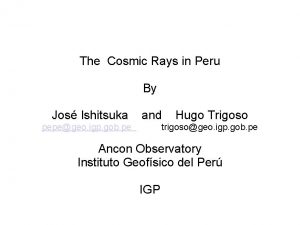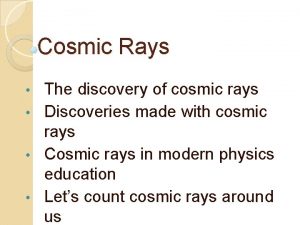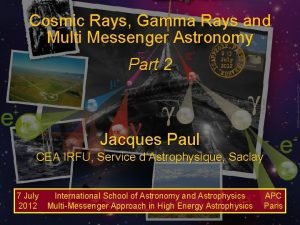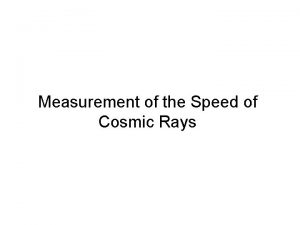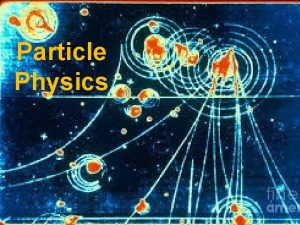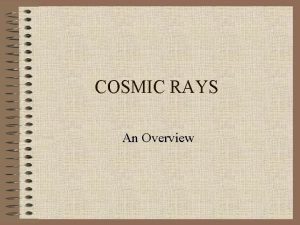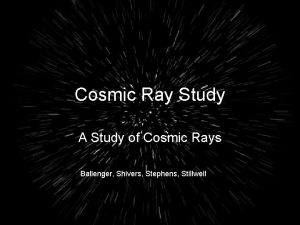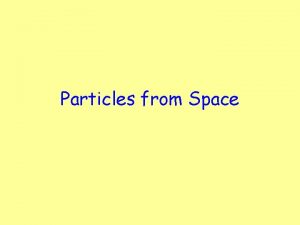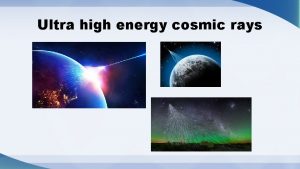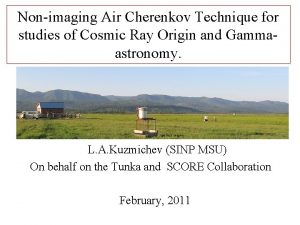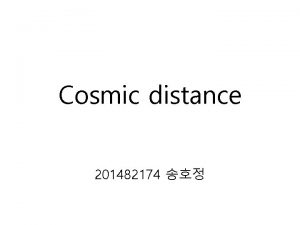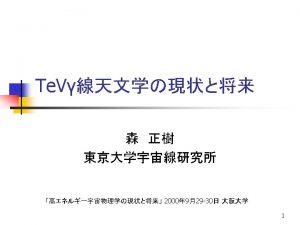Air Cherenkov Methods in Cosmic Rays A Review






































































- Slides: 70

Air Cherenkov Methods in Cosmic Rays: A Review and Some History A. S. Lidvansky, Institute for Nuclear Research, Moscow

The Vavilov-Cherenkov radiation of high energy cosmic rays in air: Ø Only extensive air showers (EAS) can produce sufficient signal to be observed against the night sky background Ø Observations are possible only in clear moonless nights (no more than 10% of calendar time) Ø There are three different lines of research in this field differing in both energy range and instrumentation

Air Cherenkov Methods 1. Investigations of Extensive Air Showers (> 1015 e. V) 2. Very High Energy Gamma Ray Astronomy (1011 -1013 e. V) 3. Experiments with Reflected Cherenkov Light (>1018 e. V) All these three lines of research were initiated by a single man! (A. E. Chudakov)

Two outstanding “CH”s P. A. Cherenkov (1904 -1990) A. E. Chudakov (1921 -2001)

A. E. Chudakov about P. A. Cherenkov: “Always a modest individual, he was extremely scrupulous not to pretend to be involved in the developing applications just because of his contribution to the effect’s discovery…” A. E. Chudakov, Pavel Alexeevich Cherenkov (Obituary), Physics Today, December 1992

“He even may have been avoided using the Cherenkov technique in his own experiments…” A. E. Chudakov, Pavel Alexeevich Cherenkov (Obituary), Physics Today, December 1992

However, in developiong the air Cherenkov technique Chudakov had some predecessors: P. Blackett in 1948 first discussed the possibility to detect the Cherenkov radiation of extensive air showers It was first detected by Galbraith and Jelly in 1952: 1. W. Galbraith and J. V. Jelley, Nature, 171, 349 (1953). 2. J. V. Jelley and W. Galbraith, Phil. Mag. , 44, 619 (1953).

Chudakov's experimental setup in Pamirs experiments (1953 -1957)

Investigations of Extensive Air Showers In these experiments, carried out in the Pamirs Mountains, the idea of calorimetric measurements of the cascade energy by recording its Cherenkov radiation was realized. Experimental ratio between the cascade energy and the observed number of particles was measured for the first time. The energy spectrum of primary cosmic rays was measured in a wide range.

Modern Cherenkov Air Shower Array (Tunka) Basic Integral Detectors Pulse Shape Detectors Remote Detector

Panorama of the Tunka array (675 m above sea level)

Pulse shape detector of Cherenkov light

QUASAR-370 light receiver

Some results of the Tunka array Shower maximum depth Differential energy spectrum p Fe

CASA-BLANCA: Cherenkov array BLANCA (144 detectors with an average separation of 35 -40 m) and CASA air shower array (a lattice of 900 scintillation detectors with a step of 15 m ).

Cherenkov and fluorescence data on cosmic ray composition

A Station of the Yakutsk EAS Array

A plan of the location of detector stations of the Yakutsk EAS Array

The Cherenkov Light Detector of Yakutsk EAS array

Estimation of shower energy E 0 The calorimetric method The relation between parameters S 300 or S 600 and primary particle energy E 0 for showers close to the vertical has been determined by the calorimetric method. For the average showers with different S 300 or S 600 E 0 is estimated as the sum separate a components: E 0 = Ei + Eel + Eμi + Eν + Eh Ei = k is the energy lost by a shower over the observation level. It is estimated by measurements of total Cerenkov light flux , and k = 2. 16 104 / (0. 37 + 1. 1 (Xm /1000) in the interval of waves 300 -800 nm In view of mean atmospheric transmittance Eel = 2. 2 106 Ns N is the energy conveyed below the array level. It is estimated by the attenuation length through the atmosphere depth E = N N of the number of charged particles Ns is the energy of the muon component. It is estimated by the total number of muons N and average energy on one muon = 10. 6 109 e. V

E i + E = 0. 76 E are the energy of muons losses on ionization and the neutrino Eh = 0. 06 Ei is the energy on nuclear reactions in the atmosphere. Red components are added on the basis of model calculation results. For E 0 1019 e. V : Ei / E 0 74%; Eel / E 0 15%; Eμ / E 0 3. 6%; (Eμi + Eν + Eh) / E 0 7. 4%

Lateral distribution of EAS Cerenkov light, <30 , 1015 <E 0 < 3 1019 e. V Q(R) = Q 150 ((62+R)/212)-1 ((200+R)/(350))1 -m, m = (1. 15 0. 05) + (0. 30 0. 06) log(Q 150)

Ratio between shower energy E 0 and S 300(0º) determined by the calorimetric method EO = (5. 66 1. 4) 1017 (S 300(0 )/10)0. 94 0. 02

VHE Gamma Ray Astronomy The gamma ray telescope constructed by Chudakov was the first instrument ever specially designed for observations of gamma rays from space. The method was suggested in a paper by G. T. Zatsepin and A. E. Chudakov, «On the methods of searching for local sources of high energy photons» , J. Exp. Theor. Phys. , vol. 41 (1961), p. 655 (In Russian).

First Gamma-Ray Telescope Katsively, Crimea (19601963)

One Cherenkov light receiver of the first gamma ray telescope

Four mirrors were installed in the season 1960, and all twelve mirrors were used in the remaining seasons 1961, 1962, and 1963.

Crab Nebula is the first detected object and the ‘standard candle’ of the VHE gamma ray astronomy

First Gamma-Ray Telescope

The negative result of Chudakov’s experiment was important in one respect: It was generally believed at that time that the synchrotron radiation in the Crab Nebula is due to electrons of secondary origin (produced by pions generated in proton-proton collisions via e decay). If so, one would expect a significant gamma ray flux from decays of neutral pions. The upper limit obtained by Chudakov was a proof of direct acceleration of electrons in the Crab Nebula (and other sources).

The idea of air fluoresence experiments was also put forward by A. E. Chudakov V. A. Belyaev & A. E. Chudakov, Ionization glow of air and its possible use for air shower detection, Bulletin of USSR Academy of Sciences, Phys. Ser. , 1966, vol. 30, no. 10, p. 1700

EUSO: Extreme Universe Space Observatory Accommodation onboard the ISS


Multiple mirror-telescopes

Stereoscopic observations in VHE astronomy

French telescope CAT (Perinei mountains)

Telescope Hegra at Canary Islands CT-3 CT-4

Australian. Japanese telescope Cangaroo II

Stereoscopic CANGAROO III telescope (Project)

CANGAROO III under construction (July 2003)

HESS (High Energy Stereoscopic System) air Cherenkov telescope in Namibia

One HESS reflector

VERITAS (Very Energetic Radiation Imaging Telescope Array System) An array of seven 10 m - 12 m optical reflectors for gamma-ray astronomy in the Ge. V - Te. V energy range

One Veritas reflector The new array design will be based on the design of the existing 10 m gamma-ray telescope of the Whipple Observatory.

PM tube camera of Veritas (499 pixels) The full field of view is 3. 5°.

New 17 m MAGIC telescope. Plans…

… and reality MAGIC under construction

MAGIC site

Magic I is operational, Magic II is planned

Global coverage of most powerful VHE Cherenkov telescopes MAGIC VERITAS HESS CANGAROO-3

Te. V Gamma Ray Sky: ~ 10 galactic and 8 extragalactic sources Almost all sources are identified, their number increases every year

Classes of objects in Te. V Catalog: AGN Radio Galaxy Starburst Galaxy Supernova Remnants Binary Source OB Association

Multi-wave observations of Mrk 421

AGN jet emission

Cherenkov astronomy at solar power plants

An example of solar power plant used as an air Cherenkov telescope (STACEE)

STACEE: Solar Tower Atmospheric Cherenkov Effect Experiment (New Mexico) Secondary mirror and detecting system

Solar II experiment (Barstow, CA)

Che. SS Project: Japanese telescope SUBARU (Hawaii) Optical-infrared telescope with a 8. 3 m mirror at 4000 m a. s. l. Che. SS (Cherenkov light detecting System on Subaru) is aimed to detect 10 Ge. V gamma rays

Chudakov’s suggestion of experiments with snow-reflected Cherenkov radiation: A. E. Chudakov, A possible method to detect EAS through Cherenkov radiation reflected from snowy ground surface, in “Experimental methods of studying cosmic rays of ultra-high energies”, Proc. of All-Union Symposium, Yakutsk, 1972, p. 69.

Original Chudakov’s suggestion was never implemented Chudakov in his suggestion had in mind the airplane experiment during polar night Some attempts were made to observe reflected EAS signal in mountains Now the idea of a fixed balloon is realized and the project of an experiment with a high-altitude balloon is under development

Experiment SPHERE-1 with a fixed balloon

SPHERE-2 design and operation

Results of the SPHERE-1 detector

BACH: Balloon Air CHerenkov experiment Direct measurements of the flux of iron nuclei with energy threshold of 2. 2. 1013 e. V

New ideas in air Cherenkov technique application: Neutrino physics and astronomy Earth-skimming and mountain-traversing neutrinos Nu. Tel collaboration prepares an experiment at Hawaii

Window of opportunity Conventional n detector ? Nu. Tel UHECR n detector

Combination of Cherenkov and fluorescence techniques

Two outstanding “CH”s P. A. Cherenkov (1904 -1990) A. E. Chudakov (1921 -2001)

Conclusions: The radiation first discovered by P. A. Cherenkov serves as a basis for a variety of methods in cosmic ray studies Among them, air Cherenkov methods form a separate area with several lines of research Nearly all of the latter were first developed or suggested by A. E. Chudakov whose ideas and experimental skill laid the foundation for present-day progress
 Cosmic rays discoverer
Cosmic rays discoverer Coracu
Coracu Cosmic rays
Cosmic rays Cosmic rays
Cosmic rays Cosmic ray
Cosmic ray Svensmark
Svensmark Cherenkov spectrum
Cherenkov spectrum Cherenkov radiation
Cherenkov radiation Cherenkov spectrum
Cherenkov spectrum Cherenkov
Cherenkov Cherenkov light
Cherenkov light Cherenkov radiation
Cherenkov radiation Cherenkov
Cherenkov Cherenkov light
Cherenkov light Cherenkov
Cherenkov Hadonic
Hadonic Cherenkov radiation formula
Cherenkov radiation formula Effetto cherenkov
Effetto cherenkov Cherenkov radiation
Cherenkov radiation Cherenkov radiation
Cherenkov radiation Cosmic air flights
Cosmic air flights Pt tanah air sentosa
Pt tanah air sentosa Metal coping fpd
Metal coping fpd The iac must ensure custody of air cargo using what methods
The iac must ensure custody of air cargo using what methods Air pollution control methods
Air pollution control methods Limitations of remote sensing
Limitations of remote sensing Origin of gamma rays
Origin of gamma rays Opposite rays
Opposite rays Definition of opposite rays
Definition of opposite rays Lesson 2 segments and rays
Lesson 2 segments and rays Opposite ray geometry
Opposite ray geometry A free bird leaps
A free bird leaps What materials block the light
What materials block the light Lobule of kidney
Lobule of kidney Opposite rays math
Opposite rays math Who discovered the gamma rays
Who discovered the gamma rays Gamma rays uses
Gamma rays uses N-rays
N-rays Vertical angles
Vertical angles Example of opposite rays
Example of opposite rays Opposite rays example
Opposite rays example Name two pairs of supplementary angles
Name two pairs of supplementary angles Precepts definition
Precepts definition Introduction of light
Introduction of light Infrared rays uses application
Infrared rays uses application Dissimilar fraction increasing order
Dissimilar fraction increasing order Opposite rays example
Opposite rays example Protective housing x ray tube
Protective housing x ray tube Origin of x rays
Origin of x rays Mitoses
Mitoses Skew rays in optical fiber
Skew rays in optical fiber Tangent rays of the sun
Tangent rays of the sun Beta minus decay
Beta minus decay Properties of cathode rays
Properties of cathode rays Sensitized material in photography drawing
Sensitized material in photography drawing Caudal fin shark
Caudal fin shark Characteristics of ultraviolet rays
Characteristics of ultraviolet rays Decay series example
Decay series example Skew rays in optical fiber
Skew rays in optical fiber X rays
X rays Direct and indirect rays of the sun
Direct and indirect rays of the sun Who discovered x rays
Who discovered x rays Lesson 1-3 segments rays parallel lines and planes
Lesson 1-3 segments rays parallel lines and planes Extreme low frequency
Extreme low frequency Medula rays
Medula rays Ray frey auto
Ray frey auto Cross section of a tree trunk labeled
Cross section of a tree trunk labeled Who discovered x rays
Who discovered x rays Hip fracture x rays
Hip fracture x rays What is split complementary color scheme
What is split complementary color scheme Optical fiber waveguides
Optical fiber waveguides
